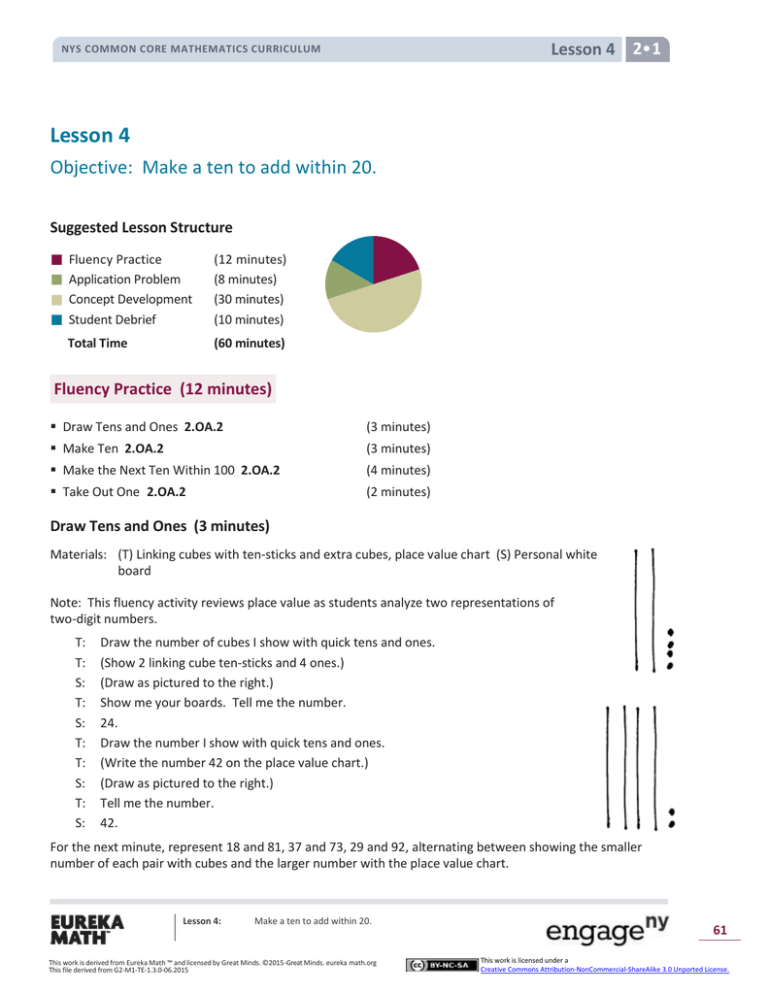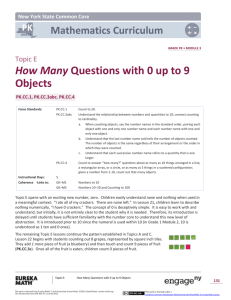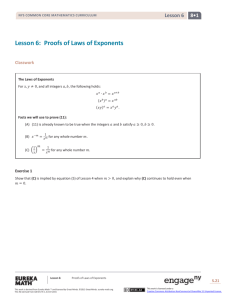Grade 2 Mathematics Module 1, Topic B, Lesson 4
advertisement

Lesson 4 2 NYS COMMON CORE MATHEMATICS CURRICULUM Lesson 4 Objective: Make a ten to add within 20. Suggested Lesson Structure Fluency Practice Application Problem Concept Development Student Debrief Total Time (12 minutes) (8 minutes) (30 minutes) (10 minutes) (60 minutes) Fluency Practice (12 minutes) Draw Tens and Ones 2.OA.2 (3 minutes) Make Ten 2.OA.2 (3 minutes) Make the Next Ten Within 100 2.OA.2 (4 minutes) Take Out One 2.OA.2 (2 minutes) Draw Tens and Ones (3 minutes) Materials: (T) Linking cubes with ten-sticks and extra cubes, place value chart (S) Personal white board Note: This fluency activity reviews place value as students analyze two representations of two-digit numbers. T: T: S: T: S: T: T: S: T: S: Draw the number of cubes I show with quick tens and ones. (Show 2 linking cube ten-sticks and 4 ones.) (Draw as pictured to the right.) Show me your boards. Tell me the number. 24. Draw the number I show with quick tens and ones. (Write the number 42 on the place value chart.) (Draw as pictured to the right.) Tell me the number. 42. For the next minute, represent 18 and 81, 37 and 73, 29 and 92, alternating between showing the smaller number of each pair with cubes and the larger number with the place value chart. Lesson 4: Make a ten to add within 20. This work is derived from Eureka Math ™ and licensed by Great Minds. ©2015 -Great Minds. eureka math.org This file derived from G2-M1-TE-1.3.0-06.2015 61 This work is licensed under a Creative Commons Attribution-NonCommercial-ShareAlike 3.0 Unported License. Lesson 4 2 NYS COMMON CORE MATHEMATICS CURRICULUM Make Ten (3 minutes) Materials: (S) Personal white board Note: This is a foundational skill for mastery of sums and differences to 20. T: T: S: T: S: T: T: S: T: S: I’ll say a number, and you say how many more to make ten. 9. Get ready. 1. Write the addition sentence. (Pause.) Show me your boards. (Show 9 + 1 = 10.) (Scan each board, and accept 1 + 9 = 10, 10 = 9 + 1, etc.) 8. (Pause as students write.) Get ready. 2. Write the addition sentence. (Pause.) Show me your boards. (Show 8 + 2 = 10.) Continue with the following possible sequence: 2, 5, 6, 4, 7, and 3. Make the Next Ten Within 100 (4 minutes) Materials: (T) Rekenrek (S) Personal white board Note: In this fluency activity, students apply their knowledge of partners to ten to find analogous partners to 20, 30, and 40 to prepare for today’s lesson. Keep them motivated to use the patterns by removing the Rekenrek at times. T: S: T: S: T: S: T: T: S: T: S: T: S: T: (Show 19.) Say the number. 19. NOTES ON Write the number sentence, starting with 19, to get to MULTIPLE MEANS or make the next ten on your personal white board. OF REPRESENTATION: (Write 19 + 1 = 20.) Once the Rekenrek is removed, encourage students who need support (Scan the boards.) Tell me the addition sentence. to visualize the beads (ten-frames or 519 + 1 = 20. groups), or guide them to use fingers to (Move 1 bead to make 20 as students answer.) model the number of ones in order to determine how many more make ten. (Show 39.) Say the number. 39. Write the number sentence, starting with 39, to make the next ten on your personal white board. (Write 39 + 1 = 40.) (Scan the boards.) Tell me the addition sentence. 39 + 1 = 40. (Move 1 bead to make 40 as students answer.) Continue with the following possible sequence: 15, 35, 85; 18, 48, 68; 12, 52, and 92. Lesson 4: Make a ten to add within 20. This work is derived from Eureka Math ™ and licensed by Great Minds. ©2015 -Great Minds. eureka math.org This file derived from G2-M1-TE-1.3.0-06.2015 62 This work is licensed under a Creative Commons Attribution-NonCommercial-ShareAlike 3.0 Unported License. NYS COMMON CORE MATHEMATICS CURRICULUM Lesson 4 2 Take Out One (2 minutes) Materials: (S) Personal white board Note: In the lesson, students add 9 and 6 by adding 9 and 1 and 5. They “take out 1” from 5. T: Let’s take out 1 from each number. I say 5. You write the number bond and say the two parts, 1 and 4. T: 5. S: (Draw number bond.) 1 and 4. Continue with the following possible sequence: 3, 10, 4, 7, 9, 8, and 6. Application Problem (8 minutes) Mark had a stick of 9 green linking cubes. His friend gave him 4 yellow linking cubes. How many linking cubes does Mark have now? MP.2 NOTES ON MULTIPLE MEANS OF REPRESENTATION: “Mark’s Linking Cubes” bridges into today’s Concept Development of making a ten to add. Rather than teach the make ten strategy during the Application Problem, notice what strategies students are independently using, and integrate these observations into the Concept Development. During the Student Debrief, consider coming back to the Application Problem, and invite students to apply today’s learning to show another way to solve the problem. Note: This add to result unknown problem’s tape diagram can be compared to that of Lesson 3 when a part was subtracted. Concept Development (30 minutes) Materials: (S) Personal white board Part 1: Making ten from an addend of 9, 8, or 7. Note: In Grade 1, students used ten-sticks and quick ten drawings extensively when making ten. Now in Grade 2, the objective is to work at the numerical level as soon as possible. T: T: (Write 9 + 4 on the board.) Let’s draw to solve 9 + 4 using circles and Xs. Lesson 4: Make a ten to add within 20. This work is derived from Eureka Math ™ and licensed by Great Minds. ©2015 -Great Minds. eureka math.org This file derived from G2-M1-TE-1.3.0-06.2015 NOTES ON MULTIPLE MEANS OF ENGAGEMENT: If time or precision is a factor, create templates of pre-drawn circles to model addends of 9, 8, and 7. Then, students can attend to drawing Xs to complete the ten and model the remainder of the problem. 63 This work is licensed under a Creative Commons Attribution-NonCommercial-ShareAlike 3.0 Unported License. Lesson 4 2 NYS COMMON CORE MATHEMATICS CURRICULUM T: T: S: T: T: S: T: S: T: S: T: S: T: S: T: T: T: (Quickly draw and count aloud 9 circles in a 5-group column as seen in the first image.) How many Xs will we add? 4 Xs. (Using the X symbol, complete the ten and draw the other 3 Xs to the right as seen in the second image.) Did we make a ten? Yes! Our 9 + 4 is now a ten-plus fact. What fact can you see in the drawing? 10 + 3 = 13. 10 + 3 equals? 13. So, 9 + 4 equals? 13. (Write the solution.) What did we take out of 4 so that we could make 10? 1. (Draw the number bond under 4 as shown to the right.) (Write 9 + 5.) Solve using a number bond. (If students want or need to draw, allow them to.) Continue with the following possible sequence: 9 + 6, 9 + 7, 8 + 9, 8 + 3, 8 + 4, 8 + 7, and 7 + 5. Have students explain their work to a partner. Part 2: Observing patterns. T: S: T: S: T: S: Look at our list of problems where one part, or addend, is 9. Tell your partner what you notice about adding to 9. You get 1 out! The answer is 10 and 1 less than the other addend. Look at the problems with 8 as an addend. Tell your partner what you notice. You get 2 out! You always take 2 out of the other addend. How is solving 9 + 4 and 8 + 4 different? We used 2 to make 10 when we added to 8 and 1 to make 10 when we added to 9. We used a different number bond. Problem Set (10 minutes) Students should do their personal best to complete the Problem Set within the allotted 10 minutes. Some problems do not specify a method for solving. This is an intentional reduction of scaffolding that invokes MP.5, Use Appropriate Tools Strategically. Students should solve these problems using the RDW approach used for Application Problems. Lesson 4: Make a ten to add within 20. This work is derived from Eureka Math ™ and licensed by Great Minds. ©2015 -Great Minds. eureka math.org This file derived from G2-M1-TE-1.3.0-06.2015 64 This work is licensed under a Creative Commons Attribution-NonCommercial-ShareAlike 3.0 Unported License. NYS COMMON CORE MATHEMATICS CURRICULUM Lesson 4 2 Student Debrief (10 minutes) Lesson Objective: Make a ten to add within 20. The Student Debrief is intended to invite reflection and active processing of the total lesson experience. Invite students to review their solutions for the Problem Set. They should check work by comparing answers with a partner before going over answers as a class. Look for misconceptions or misunderstandings that can be addressed in the Debrief. Guide students in a conversation to debrief the Problem Set and process the lesson. Any combination of the questions below may be used to lead the discussion. Let’s look at Problems 11–14. How are the problems the same and different? Do you notice a pattern that will help you memorize your 9-plus facts? What other patterns do you notice? Explain the strategy we reviewed today. Can you think of another problem that the make ten strategy will help us solve? Can you figure out the math goal of today’s lesson? What name would you give this lesson? Exit Ticket (3 minutes) After the Student Debrief, instruct students to complete the Exit Ticket. A review of their work will help with assessing students’ understanding of the concepts that were presented in today’s lesson and planning more effectively for future lessons. The questions may be read aloud to the students. Lesson 4: Make a ten to add within 20. This work is derived from Eureka Math ™ and licensed by Great Minds. ©2015 -Great Minds. eureka math.org This file derived from G2-M1-TE-1.3.0-06.2015 65 This work is licensed under a Creative Commons Attribution-NonCommercial-ShareAlike 3.0 Unported License. Lesson 4 Problem Set 2 1 NYS COMMON CORE MATHEMATICS CURRICULUM Name Date Solve. 1. 9 + 3 = ____ 2. 9 + 5 = ____ 3. 8 + 4 = _____ 4. 8 + 7 = _____ 5. 7 + 5 = _____ 6. 7 + 6 = _____ 7. 8 + 8 = _____ 8. 9 + 8 = _____ Lesson 4: Make a ten to add within 20. This work is derived from Eureka Math ™ and licensed by Great Minds. ©2015 -Great Minds. eureka math.org This file derived from G2-M1-TE-1.3.0-06.2015 66 This work is licensed under a Creative Commons Attribution-NonCommercial-ShareAlike 3.0 Unported License. Lesson 4 Problem Set 2 1 NYS COMMON CORE MATHEMATICS CURRICULUM Solve. 9. 10. 10 + ____ = 12 10 + ____ = 13 9 + ____ = 12 9 + ____ = 13 11. 12. 10 + ____ = 14 10 + ____ = 16 8 + ____ = 14 7 + ____ = 16 13. Lisa has 2 blue beads and 9 purple beads. How many beads does Lisa have in all? Lisa has _____ beads in all. _________________________________________________________________ 14. Ben had 8 pencils and bought 5 more. How many pencils does Ben have altogether? _______________________________ Lesson 4: Make a ten to add within 20. This work is derived from Eureka Math ™ and licensed by Great Minds. ©2015 -Great Minds. eureka math.org This file derived from G2-M1-TE-1.3.0-06.2015 67 This work is licensed under a Creative Commons Attribution-NonCommercial-ShareAlike 3.0 Unported License. Lesson 4 Exit Ticket 2 1 NYS COMMON CORE MATHEMATICS CURRICULUM Name Date Solve. 1. 9 + 6 = ____ 2. 8 + 5 = ____ Lesson 4: Make a ten to add within 20. This work is derived from Eureka Math ™ and licensed by Great Minds. ©2015 -Great Minds. eureka math.org This file derived from G2-M1-TE-1.3.0-06.2015 68 This work is licensed under a Creative Commons Attribution-NonCommercial-ShareAlike 3.0 Unported License. Lesson 4 Homework 2 1 NYS COMMON CORE MATHEMATICS CURRICULUM Name Date Solve. 1. 8 + 4 = ____ /\ 2 2 2. 9 + 7 = ____ 8 + 2 = 10 10 + 2 = 12 3. 9 + 3 = _____ 4. 8 + 6 = _____ 5. 7 + 6 = _____ 6. 7 + 8 = _____ 7. 8 + 8 = _____ 8. 8 + 9 = _____ Lesson 4: Make a ten to add within 20. This work is derived from Eureka Math ™ and licensed by Great Minds. ©2015 -Great Minds. eureka math.org This file derived from G2-M1-TE-1.3.0-06.2015 69 This work is licensed under a Creative Commons Attribution-NonCommercial-ShareAlike 3.0 Unported License. Lesson 4 Homework 2 1 NYS COMMON CORE MATHEMATICS CURRICULUM 9. Solve and match. A B 10 + ____ = 12 9 + 8 = ____ 10 + ____ = 13 9 + 6 = ____ 10 + ____ = 17 7 + 6 = ____ 10 + ____ = 15 6 + 8 = ____ 4 + ____ = 14 3 + 9 = ____ 10. Ronnie uses 5 brown bricks and 8 red bricks to build a fort. How many bricks does Ronnie use in all? Ronnie uses _____ bricks. Lesson 4: Make a ten to add within 20. This work is derived from Eureka Math ™ and licensed by Great Minds. ©2015 -Great Minds. eureka math.org This file derived from G2-M1-TE-1.3.0-06.2015 70 This work is licensed under a Creative Commons Attribution-NonCommercial-ShareAlike 3.0 Unported License.









